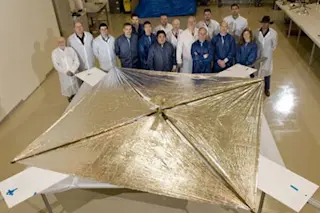When the private space company SpaceX launches its Falcon 1 rocket at the end of July, it will bring an intriguing experiment into orbit: a small NASA satellite that could be maneuvered through space with an attached "solar sail." The sail would be powered by photons from the sun hitting the reflective surface, a series of tiny impacts that can provide a boost in the frictionless void of space. In a video, NASA scientists show off a satellite about the size and shape of a shoebox with four masts that spring out to support the sail, which measures 100 square feet when unfurled. If the sail is successfully deployed, NASA will experiment with using the sail to control the satellite's altitude and orbital maneuvering. To understand this technology's potential, consider that
it took the Voyager probes 30 years to get to the edge of the solar system where they are ...














